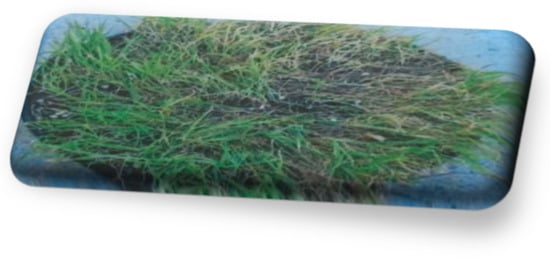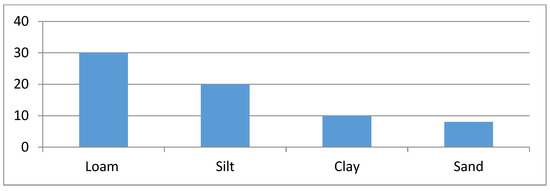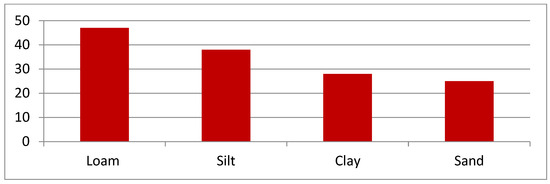Abstract
Soil texture is an important environmental factor that influences the crop productivity of wheat (Triticum aestivum) because it provides all the nutrients required for growth of the plants. The soil based on nutrients is classified into four classes: silt, clay, sand, and loam. Soil based on mineral particles was classified by the United States Department of Agriculture (USDA). According to USDA, loam particles have a size between sand (2.00–1.0 mm) and silt (0.05–0.002 mm), whereas clay is less than 0.002 mm. Analysis shows that the growth rate of Triticum aestivum in each soil sample is different. The sizes of seven plants were increased in loamy soil, to 47 cm, whereas in sandy soil, plants were 25 cm long. Seven plants were grown in clay soil, and had lengths of 28 cm. Finally, five plants were grown in silt soil, and reached a size of 38 cm. After fertilizing each plant in the different soils equally, that the productivity of plants in loamy soil was observed to be greater as compared to plants of other soil samples. Clay soil plants showed improvements as compared to sand and silt soil, although not as good as loam. The worst growing plants were observed in sandy soil. This shows that the growth of Triticum aestivum plants is better in loamy soil, and loamy soil is the most beneficial for wheat crop productivity.
1. Introduction
Vegetation plays a multidimensional role in human life, providing food, shelter, and other aspects [1]. Wheat is the staple food of Pakistan. Therefore, it is necessary to assess the effect of different types of soil texture on the wheat plant [2].
1.1. Types of Soil on the Basis of Nutrients
On the basis of nutrient contents, soil is divided into four categories, i.e., clay, sand, silt, and loam. Although different soils have a wide range of colors, textures, and other distinguishing features, there are only four types of soil particles that geologists consider distinct [3]. The quality of soil depends upon the amounts of sand, loam, silt, and clay that it contains, because varying the amounts of these particles results in very different soil characteristics [4]. Soil with a large amount of clay is sometimes hard to work with, due to some of the clay characteristics [5].
1.2. Physical Properties of Clay Soil
- Clay is a fine-grained natural rock or soil material that combines one or more clay minerals with traces of metal oxides and organic matter;
- Geologic clay deposits are mostly composed of phyllosilicate minerals containing a variable amount of water trapped in the mineral structure;
- Clay is plastic due to the water content, and becomes hard, brittle, and non-plastic upon drying;
- Depending upon the content of the soil in which it is found, clay can appear in various colors, from white to dull grey or brown to deep orange-red [6].
1.3. Physical Properties of Sandy Soil
- Sandy soil has a light texture and loose structure, which causes rapid water drainage;
- This can lead to low fertility; however, with the addition of some compost, manure, or leaf mold, sandy soil can grow a satisfactory garden;
- Sandy soil dries quickly, and it is easy to work in this type of soil;
- Sand is primarily composed of finely granulated silica and, depending on its location, shell fragments;
- It is lightweight and easily transported by wind and water;
- Its composition directly affects its color, resulting in black, white, pink and green coloring [7].
1.4. Physical Properties of Silt Soil
- The soil is different from sandy soil, having a greater tendency to form a crust that is often very hard;
- If it is over-tilled, it can become compact, which decreases its ability to infiltrate water in wet periods;
- In dry conditions, it can become hard and difficult to till;
- However, it is generally easy to fill and can store a considerable amount of water;
- Silt soil requires good reconsolidation, although tillage in wet conditions should be avoided.
1.5. Physical Properties of Loamy Soil
- Loam soil is composed of most of the sand, silt, and a smaller amount of clay;
- Its composition is about a 20–40% concentration of sand, silt, and clay, respectively;
- These properties can vary to a degree; however, this results in different types of loam soil, silty loam, sandy loam, clay loam, sandy loam, silty clay loam, and loam.
2. Materials and Methods
This study assessed the effect of soil on the wheat plant. For this purpose, 16 pots were taken and divided into 4 groups, with each group containing 4 pots. Subsequently, each group of pots was filled with the different type of soil: sandy, loamy, clay, or silt. When the pots were filled with soils, wheat seeds were sown in these pots. The pots were watered regularly, and the urea fertilizer was given to all plants equally. After a few days, the growth of the plants in each group was measured.
3. Results
It was observed that some plants were larger, some were smaller. Some pots had a larger number and increased quantity of plants on regular basis. According to the first observation after 43 days, the length of the plants in loamy soil was 30 cm, and there were 54 plants in total; the length of the plants in sandy soil was about 8 cm, and there were 18 plants in total. The plants in the 3rd group, the group which contained clay soil, were 10 cm long and there were 33 plants in total; the plants grown in silt soil were 20 cm long, with 35 plants in this group. After 90 days, another observation was performed, and this time, the plants were grown properly. According to this observation the length of loamy soil plants was 47 cm, and the length of plants in silt soil was 38 cm. Figure 1 highlights the crop productivity in loamy soil. The plants grown in clay soil were 28 cm long, whereas plants grown in sand soil were 25 cm long. The results of both analyses are shown in Figure 2 and Figure 3.

Figure 1.
Wheat crop production in loamy soil.

Figure 2.
Analysis of plant growth after 43 days (size in cm).

Figure 3.
Analysis of plant growth after 133 days (size in cm).
4. Conclusions
This study presents the impacts of different types of soils on wheat crop (Triticum aestivum). The soil samples were loam, silt, clay, and sand. Clay soil is a powdery mass, with fewer air spaces; when water is flowing through this soil, it becomes a dry and hard mass, and fewer organic and inorganic minerals are found. In sandy soil, more air spaces are present, and it has a very low water-holding capacity. After observing wheat crop productivity, it can be concluded that there is much greater growth in loamy soil. The main reason behind this is that loamy soil contains a mixture of other soil. All the essential components for the growth of plants are found in a loamy soil. It can also be concluded that loamy soil is beneficial for the better production of wheat plants due to the high amount of organic matter, inorganic matters, and high water-holding capacity.
References
- Senapati, N.S.; Ghosh, A.R. Towards management practices for sustainable agriculture: Modelling initiative. SATSA Mukhapatra-Annu. Tech. Issue 2015, 19, 49–58. [Google Scholar]
- Duxbury, J.M.; Abrol, I.P.; Gupta, R.K.; Bronson, K.F. Analysis of long-term soil fertility experiments with rice-wheat rotations in South Asia. Rice-Wheat Consort. Pap. Ser. 2000, 6, 7–22. [Google Scholar]
- Saxton, K.E.; Rawls, W.J. Soil Water Characteristic Estimates by Texture and Organic Matter for Hydrologic Solutions. Soil Sci. Soc. Am. J. 2006, 70, 1569–1578. [Google Scholar] [CrossRef] [Green Version]
- Liu, H.L.; Yang, J.Y.; Drury, C.A.; Reynolds, W.D.; Tan, C.S.; Bai, Y.L.; Hoogenboom, G. Using the DSSAT-CERES-Maize model to simulate crop yield and nitrogen cycling in fields under long-term continuous maize production. Nutr. Cycl. Agroecosyst. 2011, 89, 313–328. [Google Scholar] [CrossRef]
- Wright, S.F.; Upadhyaya, A. A survey of soils for aggregate stability and glomalin, a glycoprotein produced by hyphae of arbuscular mycorrhizal fungi. Plant Soil 1998, 198, 97–107. [Google Scholar] [CrossRef]
- Haines, W. Studies in the physical properties of soil. V. The hysteresis effect in capillary properties, and the modes of moisture distribution associated therewith. J. Agric. Sci. 1930, 20, 97–116. [Google Scholar] [CrossRef]
- Horn, R.; Taubner, H.; Wuttke, M.; Baumgartl, T. Soil physical properties related to soil structure. Soil Tillage Res. 1994, 30, 187–216. [Google Scholar] [CrossRef]
Publisher’s Note: MDPI stays neutral with regard to jurisdictional claims in published maps and institutional affiliations. |
© 2021 by the authors. Licensee MDPI, Basel, Switzerland. This article is an open access article distributed under the terms and conditions of the Creative Commons Attribution (CC BY) license (https://creativecommons.org/licenses/by/4.0/).